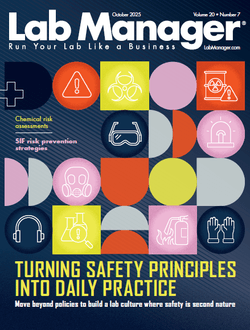The response to the first Lab Manager Salary and Budget Survey was excellent. Scientists and managers from the U.S. and internationally took part answering the 20 questions on where they work, how much they make and can spend, as well as some answers to less tangible but still important issues about job satisfaction and upward mobility.
When the survey closed, 884 respondents answered questions that gave a snapshot of some big picture items in lab management. The questions and results are listed on the following pages. Some of the correlation between dollars and workplace are made below along with some other interesting insights and comments that respondents shared. It is important to note that the survey results are based on the responses from subscribers to Lab Manager Magazine®. While the results from the data are accurate, we need to acknowledge that the survey was neither comprehensive nor exhaustive.
The paycheck
What industry pays the most? Does geographic location matter?
While the overwhelming percentage (85%) was from respondents in the U.S., 39 countries were represented in the overall results. Of that 15% outside the U.S., the largest response was from Canada followed by India.
Salary ranges and percentage results can be found in “The Results” section of this article. The big questions are how do industry and region relate to earnings?
Salary by Industry: Salary by industry results offered interesting findings. Though it may come as no surprise that university lab salaries were reported to be generally lower than the rest, government labs seemed to pay relatively well. In the over $100,000 range, biotech and industrial labs seem to offer the most earning potential while most of the clinical or research lab salaries start and remain between $46 and $104K. Some sudden dollar drop-offs occur almost across the board at the $105 to $150K range with the exception of biotech labs where the percentage jumped by almost 9%.
Average salary by industry
Pharmaceutical Lab . . . . . . . . . . . . . . . . . . . . . . . . . . . . . . . . . . . . . . . . .$69,800
Biotech Lab . . . . . . . . . . . . . . . . . . . . . . . . . . . . . . . . . . . . . . . . . . . . . . . ..$69,040
University Lab . . . . . . . . . . . . . . . . . . . . . . . . . . . . . . . . . . . . . . . . . . . . . ..$46,760
Clinical or Research Lab . . . . . . . . . . . . . . . . . . . . . . . . . . . . . . . . . . . ..$62,910
Industrial Lab . . . . . . . . . . . . . . . . . . . . . . . . . . . . . . . . . . . . . . . . . . . . . . $72,270
Government Lab . . . . . . . . . . . . . . . . . . . . . . . . . . . . . . . . . . . . . . . . . . ...$69,040
Private Lab . . . . . . . . . . . . . . . . . . . . . . . . . . . . . . . . . . . . . . . . . . . . . . . . .$64,050
Other . . . . . . . . . . . . . . . . . . . . . . . . . . . . . . . . . . . . . . . . . . . . . . . . . . . . . .$55,000
Salary by Region: Though admittedly the salary results should not be the basis to pack up your bags and move, a “top ten” list was calculated by comparing the number of respondents and the salary ranges by state. If we had asked people which state they would guess had the best pay ranges, most probably would have California (the number one state for highest pay from this survey) as in the top few. Covering mainly the eastern U.S., others in the top ten are Maryland, Colorado, New Jersey, Connecticut, Michigan, Minnesota, Massachusetts, and South Carolina. The results of the average salary by region of lab managers who responded to the survey. The eight regions are:
REGION New England
(CT, ME, MA, NH, RI, VT)
South
(AL, AR, FL, GA, KY, LA, MS, MO, SC, TN)
PA/NY/NJ
Mid-Atlantic
(DE, District of Columbia, MD, NC, VA, WV)
Midwest
(IL, IN, IA, KS, MI, MN, NE, ND, OH, OK, SD, WI)
West/Northwest
(CO, HI, ID, MT, NV, OR, UT, WA, AK, WY)
California
Southwest
(AZ, NM, TX)
Overall Average: | AVERAGE SALARY $74,689.65
$64,923.08
$70,015.38
$70,673.08
$67,239.13
$71,594.60
$91,884.61
$68,999.99
$69,683.39 |
Salary by Organizational Size: The size of the organization did play a role in salary and budget dollars. In round numbers, 20% of the people who participated in the survey work in organizations of less than 100 people, 37% in organizations of 100 to 1,000 and 43% in large organizations of over 1,000 employees. The comparison of organizational size to salary and budget supported what might be expected — that the larger the organization, the larger the budget and salary ranges.


The people
The age old question, do men get paid more than women? Though the numbers are getting closer, the survey showed more men are in the role of lab management than women by over than 13%. The U.S. National Science Foundation, Division of Science Resource Statistics does periodic data tracking of science degrees awarded by discipline as well as gender and minority status. The results from 20041 showed that 50.4% of the bachelor’s degrees in all disciplines of science and engineering were awarded to women. That percentage holds true for the number of chemistry degrees as well.2 Trends from the data indicate that the numbers are remaining somewhat static.
Table 1 shows males vs. females in the salary category. The numbers show more women earning in the lower ranges (48% earning $65K and less compared to 37% for males) and fewer in the higher ranges (23% earning $86K and higher compared to 37% for males). These are simply the straight response numbers, however, and while inferences can be made, more information is needed to answer why these differences exist.
Years with Current Employer: A surprising finding was the years with the current employer. Almost 40% responded that they have been with the current employer for more than 10 years. More than half of that number (20.14%) checked the “over 20 years” box. This result may merit questions in future surveys, such as, why people stay with a single employer? Is it tenure, great benefits, the projects? In a time when the trends indicate that loyalty is still alive but that the reasons for staying are shifting (from money, security, promotion to flexibility, responsibility, and company culture), this finding may be worth looking at more closely.
Monday-Friday
Do you like your job?
Survey questions relating to inside the lab asked about job title, number of lab members, and some questions on job satisfaction.
It's good to work in a lab. An overwhelming majority (74.21%) indicated that their job satisfaction level was good to excellent (Table 2). Most findings on job satisfaction state that it’s not all about the money. But our survey indicates that about 35% percent would want an increase. However, the survey allowed respondents to only pick ONE answer from the list. So the 18.49% who chose advancement and the 10.95% who checked off more recognition, skipped over the choice of more money. This means that 65% of the respondents say their job satisfaction level would rise with a non-monetary reward.
Spending money
What's your lab's budget?
With 41% saying that their lab’s budget is over a million dollars, the good news is that 44.54% reported that this year’s budget is higher than last year and only 13.54% indicated a decrease. As expected, salary and compensation take the lion’s share of the overall budget with approximately 75% of respondents saying that 25-75% of the budget is to pay staff.
The dollars available for purchasing equipment, products, and services is over $100,000 for more than 43%. While it probably feels like it’s never enough, lab budgets have grown and buying power is higher.
Average lab by industry
Pharmaceutical Lab . . . . . . . . . . . . . . . . . . . . . . . . . . . . . . . .. . . . . . .$390,000
Biotech Lab. . . . . . . . .. . . . . . . . . . . . . . . ... .. ... ... .. . .. . . . . . .. . . . . .$437,500
University Lab . . . . . . . . . . . . . . . . . . . . . . . . . . . . . . . . .. . . . . . .. .. . .$222,000
Clinical or Research Lab ..... . . . . . . .. . . . . . . .. . ... . . .. . .. . . . . . . .$630,000
Industrial Lab . . . . . . . . . . . . . . . . . . . . . . . . . . . . . . . . . . . . . . . . . . . ..$315,000
Government Lab . . . . . . . . . . . . . . . . . . . . . . . . . . . . . . . . . . . . . . . . . $560,000
Private Lab. . . . . . . . . . . . . . . . . . . . . . . . . . . . . . . . . . . . . . . . . . . . . . .$315,000
Other. . . . . . . . . . . . . . . . . . . . . . . . . . . . . . . . . . . . . . . . . . . . . . . . . . . .$330,000
Other
Some of what was said between the lines… It was in the “other” responses that some interesting results were gleaned. The question asking, “In order to earn more, do you feel like you would have to…” offered some insights. While 46.30% said earning more meant changing employers, many typed in the response “all of the above” (choices were change employers, take an upper management position, and further your education). Other responses included:
- Sell patents
- Improve efficiency and accuracy, fully utilize labor resources and automated equipment
- Move to another country
- Continue to bring in more business
- Publish more, secure federal grants, and earn tenure
- Attract more grant money
- Give myself a raise
- Work overtime
- Dependant on Clinical Trial success
- Change fields
- Move to a lab with a larger staff and more responsibility
- Get a sex change
- Own my own company
- Do more globally
- Develop new business, build clientele
- Present a detailed argument on reasons for pay increase
- Relocate
- Present administration with salaries from similar institutions
One respondent wrote, “The entire discipline of basic science is underpaid. It is one of the few disciplines that require specific upper division education but has salaries still equivalent to that of a high school degree. I see the main salary issue coming from the granting agencies that set what portions of funding can go for what positions. Most knock down the request of payroll funding of a Research Lab Manager and substitute in the funding for the position of Post Doc. I believe the technicians/research scientists/lab managers will have to organize and petition the current salary standards, very much like the nurses and teachers have already done, to raise their respective income to match the education required and level of responsibility required of their respective positions.”
Another question that generated many written responses was “If there was one item you could include in your budget, what would it be?” Though over 41% checked “Pay raises/ bonuses,” there was a very emphatic theme in the write-in responses. Almost without exception, the write-in responses were one of these three key items:
- More lab space or a new facility
- More money for staff training and continuing ed
- Automation
Summary/conclusion
So what do lab managers want?
The survey indicates that, overall, lab managers are a happy bunch. A little more money, a bigger or renovated lab, updated technology and automation would make most of them a little happier.
This first survey will be the basis for comparison for future surveys. We look forward to following the results over time and seeing the changes and trends. —PG, BV, LS
References
- National Science Foundation, Science Resource Statistics, “Degrees awarded in all fields in science and engineering by degree level and sex of recipient: 1966–2004.” http://www.nsf.gov/statistics/nsf07307/pdf/tab3.pdf
- National Science Foundation, Science Resource Statistics, “Chemistry degrees awarded, by degree level and sex of recipient: 1966–2004.” http://www.nsf.gov/statistics/nsf07307/pdf/tab38.pdf
The response to the first Lab Manager Salary and Budget Survey was excellent. Scientists and managers from the U.S. and internationally took part answering the 20 questions on where they work, how much they make and can spend, as well as some answers to less tangible but still important issues about job satisfaction and upward mobility.
When the survey closed, 884 respondents answered questions that gave a snapshot of some big picture items in lab management. The questions and results are listed on the following pages. Some of the correlation between dollars and workplace are made below along with some other interesting insights and comments that respondents shared. It is important to note that the survey results are based on the responses from subscribers to Lab Manager Magazine®. While the results from the data are accurate, we need to acknowledge that the survey was neither comprehensive nor exhaustive.
The paycheck
What industry pays the most? Does geographic location matter?
While the overwhelming percentage (85%) was from respondents in the U.S., 39 countries were represented in the overall results. Of that 15% outside the U.S., the largest response was from Canada followed by India.
Salary ranges and percentage results can be found in “The Results” section of this article. The big questions are how do industry and region relate to earnings?
Salary by Industry: Salary by industry results offered interesting findings. Though it may come as no surprise that university lab salaries were reported to be generally lower than the rest, government labs seemed to pay relatively well. In the over $100,000 range, biotech and industrial labs seem to offer the most earning potential while most of the clinical or research lab salaries start and remain between $46 and $104K. Some sudden dollar drop-offs occur almost across the board at the $105 to $150K range with the exception of biotech labs where the percentage jumped by almost 9%.
Average salary by industry
To continue reading this article, sign up for FREE to

Membership is FREE and provides you with instant access to eNewsletters, digital publications, article archives, and more.












